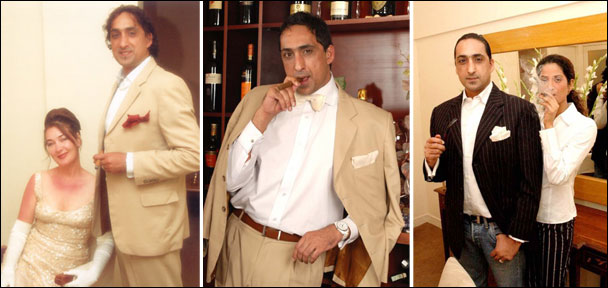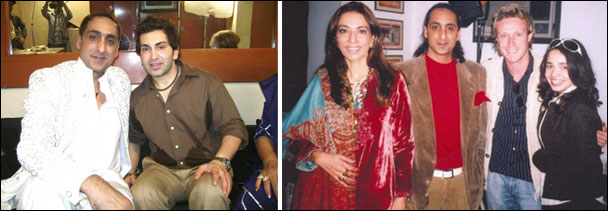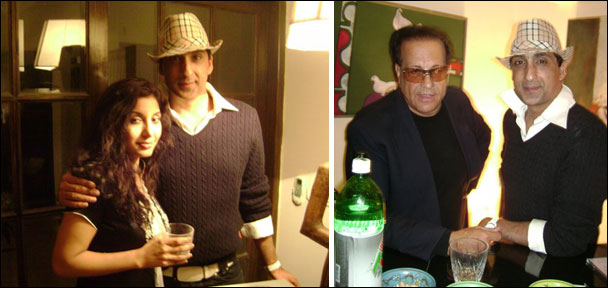|
|
| |
instep
analysis
The strange case of
Sheikh Amer Hassan
Here's the incredible story about how a fashion pariah gained
both celebrity and notoriety and why most people in fashion chose
to keep their distance
By Muniba
Kamal
|
| |
 |
| |
|
There is no denying that
the Sheikh Amer Hassan hit close to home. It hit very close to home,
a bit too close actually. This is why there was a shocked silence
when he died, broadcast journalists found few who were willing to
comment on his life. It was as if everyone was in shock. After all
most of us did know him, in the sense that we had seen him somewhere
or the other, if not at a party than in the social pages attending
one that happened recently. Sheikh Amer knew how to get around and
he may have been flanked by Nirma, Ali Saleem and Gia Ali, but he
has also been flanked by Imran and Jemima, Vaneeza Ahmed and Salman
Taseer.
We all bumped into him at parties and we were all almost always
invited to his house and most of us even went there at sometime
or another, if not frequently. Some of us were adventurous enough
to be with him, others chose to keep a distance but he was very
much within our radar.
"Sheikh Amer Hassan was not a fashion designer," says
Maheen Khan authoritatively. "I had met a couple of times over
the years. He didn't have an outlet, he did not come out with collections
and he did not even have a kaarkhana. How can he be called a fashion
designer? I am appalled that he used fashion as a front for his
nefarious activities."
But
Maheen like everyone else had met Sheikh Amer Hassan and was familiar
with him. Photographer Tapu Javeri recalls the shoot he did for
Sheikh Amer Hassan's shirts with Herald when Fifi Haroon was fashion
coordinator there. "he had come back from London and had gone
to Fifi with these four men's shirts made from chiffon and some
embellishment," recalls Tapu. "The shoot was done with
Lulu Nana and Seemi Pasha. Nabila did the hair and make-up and after
tat shoot came out one saw Sheikh Amer Hassan use exactly the same
four shirts for shoots in Men's Club and various other publications."
|
| |
 |
| |
|
That was when Tapu Javeri
stopped taking him seriously. Fashion is very selective by nature
and people automatically learn to keep a distance from those who
don't have substance as fashion people. "He emerged some years
later as a totally bizarre character. That was the beginning of
Sheikh Villa. Everyone was invited every weekend and most people
went there at some point or another."
And what about Tapu? "I knew Sheikh Amer Hassan, as did we
all, but I chose to keep my distance, because I didn't think he
was a very nice person."
Sheikh Amer Hassan was a source of amusement for many in the industry.
His Anglicised ways, his quirkiness (guests have gone there for
dinner and been amused when a dish called lentils ala rice was announced
and they were served daal chawal), his tall claims, the character
that was Boudicca Swanson, do make for an entertaining evening out
and many people did decide to swing by to Sheikh Villa, mostly on
a whim . It was mostly for comedic value, to marvel at the preposterous
lifestyle of Sheikh Amer Hassan. And when they went there, even
if it was once or twice, their pictures were taken and became part
of the myth Sheikh Amer created around himself.
"He
was a complete fake," says Frieha Altaf, "which is why
I stayed away from him. I had a meeting with him. He showed me a
rejection letter from Princess Diana and he had shots of Rizwan
Beyg's clothes in his portfolio. I even told Rizwan about it later.
He was amused, because he didn't take Sheikh Amer Hassan seriously.
Rizwan was just amused by the character SAH was."
However, Frieha is one of those people who never went to Sheikh
Villa. "I don't like the way this man operated. I refused to
endorse him in any way. I never went to his house. I never worked
with him. I never socialized with him."
The
designer who hardly designed
Frieha Altaf is a complete professional with a no -nonsense way
of running her business. She saw Sheikh Amer Hassan for a fake and
refused to take her relationship with him any further than that
of an acquaintance. Deepak Perwani in his obituary for Sheikh Amer
Hassan in a local paper said "The last time I met him (SAH)
he told me about the Montenegro Fashion Week. I remembered because
he wanted to borrow clothes from me to show there and I had laughed
because that was him."
Designers go into fits when they think another designer has copied
their ideas. They point fingers and ask journalists to point out
that they came up with the original concept. However, Sheikh Amer
Hassan seemed to have inspired none of this outward hostility; because
he wasn't a designer, no one was threatened. They just took his
antics at face value and went along, most laughing at him than with
him. Chances are Sheikh Amer Hassan knew this. They may have gone
over to Sheikh Villa, but no one was willing to work with him or
promote him.
|
|
 |
| |
|
Media types especially
stayed far away from the man. Journalist Mohsin Sayeed was horrified
more by the headlines after Sheikh Amer Hassan's death than by his
brutal murder.
"I was horrified when I opened the papers the next day and
there were all these papers calling him a top fashion designer;
they got their facts all wrong," he says. "The man had
no body of work he could speak of. Where is his shop? Where are
his collections? In fact Sheikh Amer Hassan was famous for sourcing
someone else's clothes and using them as his own at random shows
that were few and far between.
In 1999 I remember he did a fashion show right before the Boney
M concert in 1999; those clothes were made by the fashion students
of PSFD. He presented them as his own and what could the school
kids do? I don't like people who don't work and take credit for
someone else's."
And this is what Sheikh Amer Hassan did. Using his media savvy,
he became a part of the emerging social page culture. Indeed Tapu
Javeri, who also has his Masters in Anthropology observes, "The
modern culture of inviting people to your home and thrusting a camera
in their face probably originated from Sheikh Villa. Sheikh Amer
was the first one to do this, now everybody does it."
Fame without justification
In this celebrity obsessed culture, it is possible for someone to
make themselves iconic without having anything to back them. Smooth
talking gets you places and it certainly did that for Sheikh Amer
Hassan. He went all over the place, got to rub shoulders with all
the right people and even if they didn't want to get to know him
any better, the pictures splashed of him regularly sent a message
out to the outside world that he was a big shot in fashion. He was
even interviewed by the BBC once as one of Pakistan's leading designers.
This image that is sent out becomes all the more worrying when Ameer
Hamza Awan, the young man arrested for murdering him says that he
followed all of Sheikh Amer Hassan's instructions because he was
"crazy to become a model."
Hamza is from Khushab, a town in the Punjab and it hasn't been too
long since he moved to Karachi. When he looks at the social pages
and sees Sheikh Amer Hassan there and sees programs hosted by him
on television, how is he to know that the man he is looking up to
as a mentor is a non-entity in the fashion world? That there is
no one that takes Sheikh Amer seriously. That there is no way that
Sheikh Amer Hassan can ever make anyone a star.
There
is Sheikh Amer Hassan's website, www.sah-london.com where one can
apply to be a model, a singer or a dancer. If you ask around the
industry, no one used Sheikh Amer Hassan's talent pool for anything.
Leading photographers haven't worked with them. Leading choreographers
never used his models. Considering that Sheikh Amer Hassan hardly
did any shows of his own, what happened to the boys and girls who
applied to SAH London? How many more Hamzas are there out there?
|
| |
 |
| |
|
After
the Instep expose was printed when he died, one got a lot of reactions
from the fashion industry. One of the questions hurled was: "Sometimes,
these boys and girls come up to us and say that they are willing
to do us (sexual) favours to offer them a job, so what are we supposed
to do?"
The answer is very simple: you say no. The casting couch is a reality
in many industries. It is very easy to point fingers at fashion,
film and television because they are high profile by nature, but
sexual harassment and exploitation prevails in all walks of life.
The Sheikh Amer Hassan murder has opened the Pandora's box of the
casting couch in the fashion industry just because he called himself
a 'fashion designer'.
"People ask me for favours everyday,' says Frieha Altaf, who
runs possibly the most successful event management company Catwalk
in the entertainment industry. "It is very simple. If I think
you are talented I will promote you. If I don't think you are talented,
I will tell you to your face."
People like Frieha Altaf, Nabila, Tariq Amin, Ather Shahzad and
Khawar Riaz have the ability to make people and they have played
godparents to many a fashion icon. The problem with Sheikh Amer
Hassan was that while he may have promised many a person fame, fortune
and success he couldn't have delivered. The man said he was a designer
but had no body of work. He rarely did shows and neither were his
TV shows acclaimed at any level and the programs petered out within
months. His run as Fashion Director at Geo didn't last for too long
either. If Sheikh Amer Hassan had any fashion spark, it was killed
by his lack of consistency. Whatever Sheikh Villa was, it definitely
wasn't a fashion operation. However, the power of celebrity was
used to sell a mirage. For what purpose? One can only imagine...
Sheikh Villa revisited
Sheikh Villa was Sheikh Amer Hassan's boudoir. A person who visited
it for Sheikh Amer Hassan's cat's birthday recalls that the first
floor had a bed in it and big TV screens all around. She couldn't
figure out what the bed was used for. A friend of hers had dragged
her there and she decided to never go there again because the place
gave her a 'weird vibe'. Another socialite invited there for lunch
recalls "a huge circular dining table with a massive chandelier
that seemed rather incongruous in the small Zamzama flat."
Others who frequented Sheikh Villa sniggered about the cocktails
that he served, which had the fancy names but were rather basic.
Yet, in the city of Karachi with an expanding social scene and people
looking for entertainment, Sheikh Villa had a magnetic pull. No
one can be held guilty for visiting the place. The urge to see what
Sheikh Amer Hassan was all about was strong, so what if he was rather
dicey? He had a label called SAH London, but he didn't go to London
all that often. He claimed he had Dame Barbara Cartland as a god
mother and his picture with her is displayed prominently on both
his website and his facebook profile. We all know that Boudicca
Swanson, Gloria Swanson's grand daughter, came to stay with him.
Some of us met her in the flesh, always on his arm. The two were
even interviewed for television together. Ali Saleem was one of
his regular companions and Ali with his talent for mimicry and his
ready wit is hugely entertaining. Gia Ali, one of Sheikh Amer's
good friends has modeled for every designer under the sun. We all
know these people somehow or another. which is why the Sheikh Amer
Hassan case has touched such a raw nerve. Even if we chose to keep
a distance, Sheikh Amer Hassan was a part of the scene as we know
it. And when people get murdered by young men who say they have
been sexually exploited, well, we would rather that they be people
we don't know at all.
A disaster waiting to happen
Some fashion insiders have referred to the Sheikh Amer Hassan case
as 'a disaster waiting to happen.' How long would it be before a
model from the wrong sides of the tracks put a gun to his benefactor's
head? We have all known of the casting couch. We are all aware of
people who use their positions to exploit others. Our reaction as
industry professionals is how Frieha Altaf or Tapu Javeri or Maheen
or Mohsin Sayeed reacted… we choose to disassociate ourselves
from the person.
There were rumours circulating about Sheikh Amer Hassan on the industry
grapevine that made most people keep a distance. According to Mohsin
Sayeed, he stayed away from Sheikh Amer Hasan ever since a friend
of his told him that he personally saw Sheikh Amer Hassan indulging
in illicit acts most people would find reprehensible.
"I don't know this first hand," says Mohsin, "but
this friend of mine said he was with Sheikh Amer when it happened.
He saw it and was disgusted by it and chose to cut away from him.
I choose to believe my friend and after hearing that I shunned Sheikh
Amer too. A channel sent a crew over to interview me about his murder
and I agreed. When asked about how I felt about it, I said 'After
Sheikh Amer's death, the young children on the streets of Karachi
will be very happy and the little angels in heaven will be very
worried. The man wasn't a designer, he was a pervert!'"
Mohsin chooses strong words but there are similar stories that did
the rounds within the industry. These stories were the reason why
most of us chose to stay away from the man. In retrospect one thinks
how far can we blame Amer for what he did? We live in a society
where 'londaybaazi'' is an innate part of our culture - how many
times have you seen a truck driver with his arm around a pretty
young boy? The fact that our street children are used by grown men
for sex is no secret. We pass by such situations everyday, we know
what's going on, but as a society, we are all party to a conspiracy
of silence. Possibly because sex is such a taboo, we just don't
talk about it, even when it's abusive. This is the way it's always
been.
Another criticism of the Instep expose after Sheikh Amer Hassan's
murder was that "if you knew all this, why couldn't you have
exposed it in his lifetime?" It is a very good question, but
then there was no proof. And as a journalist one refrains from writing
stories that are likely to get someone shot in the head. In a country
where the Tehreek e Taliban are a reality, that is very much possible.
But now there is proof of exploitation, and it comes from Ameer
Hamza Awan who is currently under trial for the murder of Sheikh
Amer Hassan. His testimony gives one a chance to dig deeper. Sheikh
Amer Hassan's murder has opened a Pandora's box of hypocrisy and
double standards that are not very palatable. One feels that rather
than whitewash the truth, one should let it remain open and deal
with the demons that come out.
Talking about these issues would be in the best interests of everyone.
And one is glad to note that Sheikh Amer Hassan's murder has led
to that debate. I know for a fact that it is happening in drawing
rooms even if most people prefer to remain tight lipped in print.
|
| |
|

